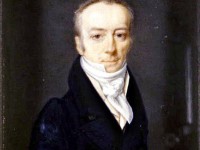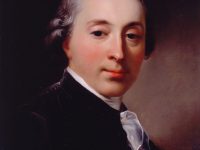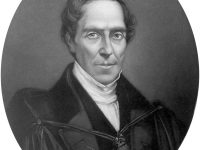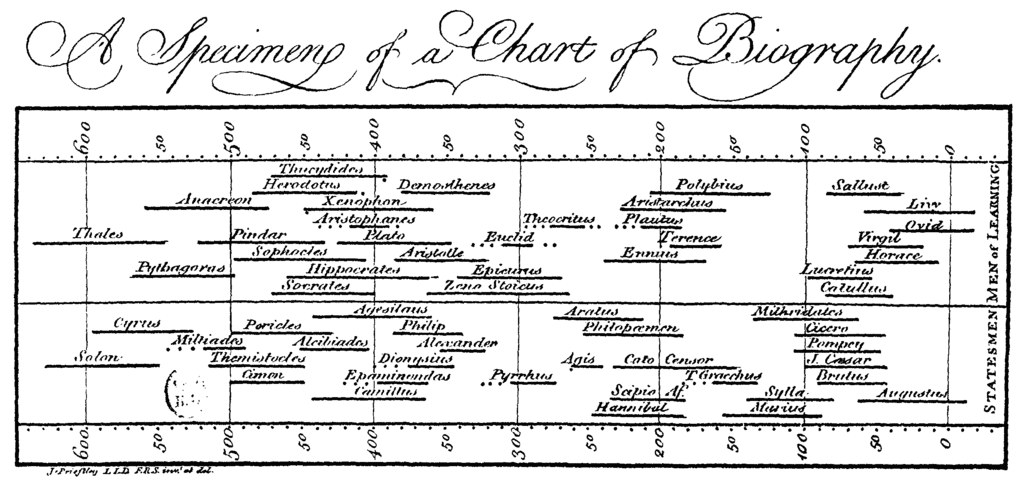
Joseph Priestley, Chart of Biography, 1756
On March 13, 1733 (March 24 according to the new Gregorian calendar), English theologian, Dissenting clergyman, natural philosopher and chemist Joseph Priestley was born. He is usually credited with the discovery of oxygen, having isolated it in its gaseous state, although Carl Wilhelm Scheele [3] and Antoine Lavoisier [4] also have a claim to the discovery. A scholar and teacher throughout his life, Priestley also made significant contributions to pedagogy, including the publication of a seminal work on English grammar, books on history, and he prepared some of the most influential early timelines.
Joseph Priestley Background
Joseph Priestley began teaching in Nantwich, Cheshire and back then he enjoyed tutoring his pupils in a wide range of topics: Latin, Greek, geography, math as well as English grammar. It is assumed that he also taught natural philosophy. Having received a decent education at Daventry, a Dissenting academy, Priestley was convinced was education was a major key to shaping people as well as the society’s future. Priestley kept supporting Dissenting academies throughout his lifetime and he consulted the founders of New College at Hackney on its curriculum. After Priestley emigrated to America in 1794, he continued his ‘mission’ and began communicating with Thomas Jefferson regarding the proper organization of a university. When the University of Virginia was founded by Jefferson, Priestley was able to highly influence the university’s educational principles. One of Joseph Priestley’s principles was his way of teaching natural philosophy. He always encouraged his students to give public presentations of their experiments. He was convinced that it was not enough to simply teach children in the subjects of grammar and rhetoric, but also tutor them in science to support their understanding of the world and the human race. Back in Birmingham, where Priestley lived in 1780, his home became a place for scientific education for the local children.
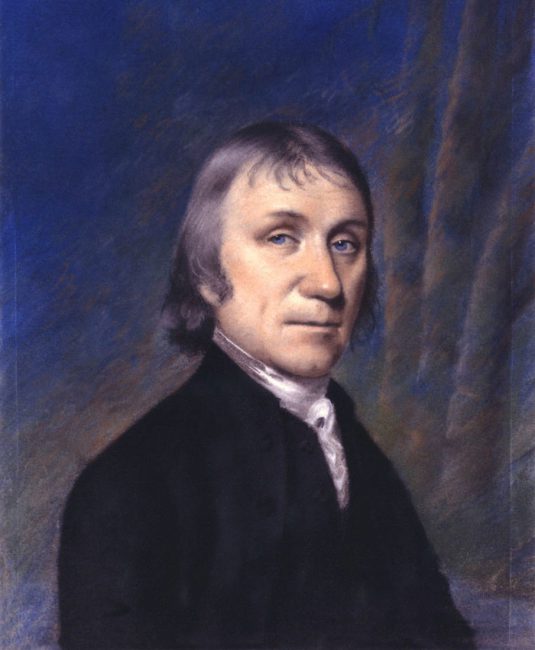
Portrait of Joseph Priestley by Ellen Sharples (1794)
Teaching Philosophy
Joseph Priestley also dedicated an Essay on a Course of Liberal Education for Civil and Active Life in 1765 to the governing board of Warrington Academy. He explained that children’s education should anticipate their practical needs instead of classical education in order to acquire useful skills. He proposed that students should lean English and the modern languages instead of the classical languages, learn practical mathematics, read modern rather than ancient history, and study the constitution and laws of England. In 1766 Warrington Academy replaced its old classical curriculum with Priestley’s new liberal arts model.
Priestley’s teaching philosophy included a great knowledge of history. He believed that understanding history was necessary not only to success but also to spiritual growth. At Warrington Academy, Priestley gave lectures on the government and history. In his lectures, Priestley did not limit himself to narrating history, he also presented a method for historical research and was one of the first to argue for the primacy of original documents in the study of history. Due to Priestley’s view that education was the key to shape a person’s character, the educator also promoted the education of women. Alluding to the language of Locke’s Essay Concerning Human Understanding, he wrote: “certainly, the minds of women are capable of the same improvement, and the same furniture, as those of men.” Further, he came to believe that if women were to care for children and be intellectually stimulating companions for their husbands, they had to be well-educated. Although Priestley advocated education for middle-class women, he did not extend this logic to the poor.
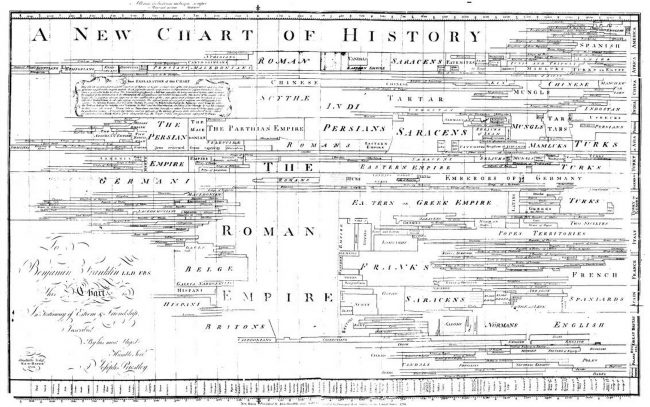
A redacted version of A New Chart of History (1765); Priestley believed this chart would “impress” upon students “a just image of the rise, progress, extent, duration, and contemporary state of all the considerable empires that have ever existed in the world”
Joseph Priestley’s Charts
In his work as a teacher, Joseph Priestley also became famous for his Chart of Biography, published in 1765 and the New Chart of History, published in 1769. These charts allowed students to “race out distinctly the dependence of events to distribute them into such periods and divisions as shall lay the whole claim of past transactions in a just and orderly manner” as he put it. The Chart of Biography included a timespan from 1200 BC to 1800 AD and about 2000 names. He established six categories, Statesman and Warriors, Divines and Metaphysicians, Mathematicians and Physicians, Poets and Artists, Orators and Critics, and Historians and Antiquarians. He devided the world’s history in several categories: Scandinavia, Poland, Russia, Great Britain, Spain, France, Italy, Turkey in Europe, Turkey in Asia, Germany, Persia, India, China, Africa and America. The goal was to show the history of empires and the passing power. His charts were highly popular, and A New Chart of History went through fifteen editions by 1816.
Natural Philosophy
Priestley’s strength as a natural philosopher was qualitative rather than quantitative and his observation of “a current of real air” between two electrified points would later interest Michael Faraday [5] and James Clerk Maxwell [6] as they investigated electromagnetism. Priestley’s text became the standard history of electricity for over a century; Alessandro Volta [7] (who later invented the battery), William Herschel [8] (who discovered infrared radiation), and Henry Cavendish [9] (who discovered hydrogen) all relied upon it. Priestley wrote a popular version of the History of Electricity for the general public titled A Familiar Introduction to the Study of Electricity (1768).
The Discovery of Oxygen
Priestley became famous because he described a special gas, the element oxygen, in a journal on 1 August 1774. When mercury(II) oxide was heated, he obtained pure mercury and a colourless gas that strongly promotes combustion processes. This gas was insoluble in water, but when it was combined with nitric oxide air, a significant reduction in gas – more pronounced than in pure air – occurred in combination with water. However, he did not realize that he had discovered a previously unknown element; rather he called his gas dephlogisticated air. Priestley remained a follower of the phlogiston theory for the rest of his life. Later he also discovered the production of dephlogisticated air by heating saltpetre (1779).
Although Priestley claimed that natural philosophy was only a hobby, he took it seriously. In his History of Electricity, he described the scientist as promoting the “security and happiness of mankind”. Priestley’s science was eminently practical and he rarely concerned himself with theoretical questions. When he moved to Leeds, Priestley continued his electrical and chemical experiments (the latter aided by a steady supply of carbon dioxide from a neighbouring brewery). Between 1767 and 1770, he presented five papers to the Royal Society from these initial experiments; the first four papers explored coronal discharges and other phenomena related to electrical discharge, while the fifth reported on the conductivity of charcoals from different sources. His subsequent experimental work focused on chemistry and pneumatics.
Impact and Legacy
Despite his extremely critical views, Priestley was a pious man throughout his life and felt himself to be a believing Christian. By the time Joseph Priestley died in 1804, he had been made a member of every major scientific society in the Western world and he had discovered numerous substances. The 19th-century French naturalist George Cuvier, in his eulogy of Priestley, praised his discoveries while at the same time lamenting his refusal to abandon phlogiston theory, calling him “the father of modern chemistry [who] never acknowledged his daughter“.
Dr. Breen Presents – France: Lavoisier Casts the Phlogiston into the Fire, [14]
References and Further Reading:
- [1] Joseph Priestley at the Joseph Priestley Society
- [2] Joseph Priestley Website
- [3] Carl Wilhelm Scheele and the Discovery of Oxygen, SciHi Blog
- [4] Modern Chemistry started with Lavoisier, SciHi Blog
- [5] A Life of Discoveries – the great Michael Faraday, SciHi Blog
- [6] James Clerk Maxwell and the Electromagnetic Fields, SciHI Blog
- [7] Alessandro Volta and the Electricity, SciHi Blog
- [8] Sir William Herschel and the Discovery of Uranus, SciHi Blog
- [9] Henry Cavendish and the Weight of the Earth, SciHi Blog
- [10] Joseph Priestley at Wikidata
- [11] Timeline for Joseph Priestley, via Wikidata
- [12] Joseph Priestley, The History and Present State of Electricity, with Original Experiments (London, England: 1767)
- [13] Priestley, Joseph. “An Account of Further Discoveries in Air“. Philosophical Transactions 65 (1775): 384–94.
- [14] Dr. Breen Presents – France: Lavoisier Casts the Phlogiston into the Fire, Bedford TV, MA @ youtube
- [15] Works of or about Joseph Priestley at Wikisource


